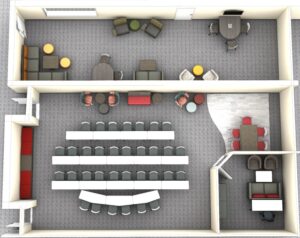
MCCC is in the process of creating a Diversity, Equity and Inclusion plan.
The DEI plan is part of MCCC’s five- year Strategic plan and will establish procedures for making MCCC a more inclusive institution.
Key steps include writing detailed goals, building a center and hiring a coordinator to service minority populations.
The DEI Plan has been named “Belonging,” to emphasize a focus on making sure all students feel they are welcome at MCCC, President Kojo Quartey said.
“We hope everybody feels a sense of belonging when they’re here,” said Melissa Grey professor of psychology and member of the DEI task force. “Students who feel like they belong at their institution, tend to be students who are more likely to persist and complete their educational goals.”
When talking with students who are not well represented, Grey said they often feel on the outside. By creating a way for them to belong and give them a voice, she said the college gets the benefit of their participation and it allows them to grow.
Rosario Mexicano-Manzano said her experience as a student and minority at MCCC has been very positive and hopes the new DEI plan will help others feel encouraged on their academic journey.
“I feel like they do a really great job of including everyone and offering surveys to express your feelings,” Mexicano-Manzano said.
Several steps have already been put in place to ensure students have the support to succeed. The DEI plan will evaluate that progress and focus on including the minority populations at MCCC.
MCCC hired Legacy Partners of Northwest Ohio in May as a consultant to choose members for the DEI Task Force and help direct the drafting process. According to the Consulting Services Agreement, the cost of the consultant was $1,500.
Quartey said there was an effort to include faculty, Board of Trustees, community, and student representation on the Task Force, which consisted of around a dozen individuals.
To fulfill the belonging initiative a document outlining the DEI goals is being drafted by the task force.
The plan was approved by the Faculty Council at it’s Nov. 16 meeting, Quartey said. After further evaluation, the draft will be presented to the Board of Trustees in Dec. or Jan. for final approval.
Quartey said the plan features six strategic goals, but the DEI Task Force is not releasing the full document until it is approved by the Board of Trustees.
- Goal 1 – Establish a sustainable Diversity, Equity, and Inclusion (DEI) infrastructure.
- Goal 2 – Foster and embrace a welcoming and inclusive community-oriented culture on campus that will permeate throughout Monroe County and its surroundings.
- Goal 3 – Improve recruitment and retention of faculty, staff, and administrators from underrepresented populations.
- Goal 4 – Build diversity and inclusion competencies for faculty, staff, and administrators.
- Goal 5 – Enhance and increase student recruitment and retention along with diversity and inclusion efforts.
- Goal 6 – Establish and/or strengthen partnerships with organizations that provide services to underrepresented populations in Monroe County and surrounding areas.
“Under the goals are a total of 28 specific action steps or objectives for how we might reach that larger goal,” Grey said.
Quartey said the plan is a living document that will undergo regular and quantitative evaluations in response to successes and failures so the goals can be progressively achieved. The assessment will allow input from staff, students and community.
Gray said it is difficult to apply these initiatives in online schooling environments.
While the “Belonging” plan is under development, a DEI center is also being constructed in the Administration Building as a place to house the efforts outlined in the plan.

“The whole area is being redone,” said Scott Behrens, Vice President of Enrollment Management and Student Success.
The DEI center will be roughly 700 square feet in area, said Jack Burns, director of Campus Planning and Facilities. The new Student Government room will be adjacent to the DEI center and be roughly 1,260 square feet. The construction for both centers is being done simultaneously.
This space will offer students a place where they can come for resources and information, as well as an area for clubs to meet in comfort, Quartey said.
It will also include unisex restrooms as seen in other updated buildings.
The center is estimated to be completed in mid-December and cost a total of around $311,100 for the architecture, engineering, design and construction, Burns said.
“It’s really about making sure that we’re doing our part to make a genuine connection with students and offering a place where these students can interact,” Behrens said.
Grey said she has enjoyed being a part of the DEI task force because creating more spaces and opportunities for marginalized groups is an important endeavor for any institution.
“We have diverse individuals on our campus and we want to ensure that they all feel they belong here,” Quartey said. “In a world of diversity of all forms, we want to ensure that all feel included and we want to look at all we do through that equity lens as we continue to serve the underserved populations.”

